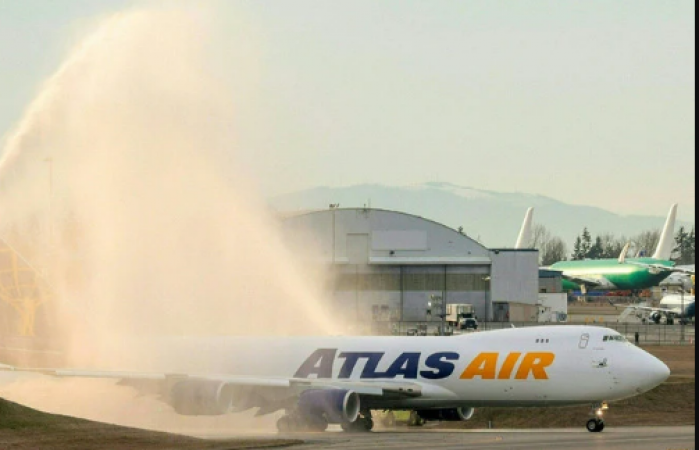
Seattle: On Tuesday, Boeing will say farewell to an icon by delivering its final 747 jumbo jet.
The giant yet graceful 747 has served as a cargo plane, a commercial aircraft capable of carrying nearly 500 passengers, a transport for NASA's space shuttles, and the presidential aircraft Air Force One since its first flight in 1969. It transformed travel by connecting international cities that had never had direct flights before and democratising passenger flight.
However, over the last 15 years, Boeing and its European rival Airbus have introduced more profitable and fuel-efficient wide-body planes with only two engines to maintain rather than the 747′s four. Boeing's final plane is the 1,574th built in Washington state's Puget Sound region.
Also Read: This Islamic country to impose Rs 4 lakh crore fine on Pak!
The final send-off is expected to draw a large crowd of current and former Boeing employees. The final one is on its way to cargo carrier Atlas Air.
"If you love this business, you've been dreading this moment," said Richard Aboulafia, a longtime aviation analyst. "Nobody wants a four-engine airliner anymore, but that doesn't diminish the aircraft's enormous contribution to the development of the industry or its remarkable legacy."
After losing a contract for a massive military transport, the C-5A, Boeing set out to build the 747. The plan was to use the new engines developed for the transport — high-bypass turbofan engines that burned less fuel by passing air around the engine core, allowing for a longer flight range — for a test flight.
More than 50,000 Boeing employees worked for less than 16 months to build the first 747, a Herculean effort that earned them the moniker "The Incredibles." The construction of a massive factory in Everett, north of Seattle, required the construction of the world's largest building by volume.
Also Read: 'Something is wrong,' Elon Musk says as he makes his Twitter account private
The fuselage of the plane measured 225 feet (68.5 metres) in length, and the tail was as tall as a six-story building. The plane's design included a second deck extending from the cockpit back over the first third of the plane, giving it a distinctive hump and inspiring a nickname, the Whale. The 747 was dubbed the "Queen of the Skies" in a more romantic sense.
Some airlines converted the second deck into a first-class cocktail lounge, and even the lower deck featured lounges or even a piano bar on occasion.
It was the first big carrier, the first widebody, so it set a new standard for airlines to figure out what to do with it and how to fill it," said Guillaume de Syon, an aviation and mobility expert at Pennsylvania's Albright College. "It became the essence of mass air travel: You couldn't fill it with people paying full price, so you need to lower prices to get people onboard. It contributed to the deregulation of air travel that occurred in the late 1970s."
The first 747 entered service on Pan Am's New York-London route in 1970, and its timing was terrible, according to Aboulafia. It debuted shortly before the 1973 oil crisis, during a recession that saw Boeing's employment fall from 100,800 in 1967 to 38,690 in April 1971. The infamous "Boeing bust" was commemorated by a billboard near Seattle-Tacoma International Airport that read, "Will the last person leaving SEATTLE — Turn out the lights?"
The 747-400 series, an updated model, arrived in the late 1980s and had much better timing, coinciding with the Asian economic boom of the early 1990s, according to Aboulafia. He remembered flying from Los Angeles to Hong Kong on a Cathay Pacific 747 as a twentysomething backpacker in 1991.
"Even people like me could travel to Asia," Aboulafia explained. "Previously, you had to stop for fuel in Alaska or Hawaii, which was much more expensive. This was a no-brainer — and reasonably priced." Delta was the last US airline to use the 747 for passenger flights, which ended in 2017, though some international carriers, including Lufthansa, continue to use it.
Atlas Air placed an order for four 747-8 freighters early last year, with the final one departing the factory on Tuesday.
Boeing has its roots in the Seattle area and assembly plants in Washington and South Carolina. In May, the company announced that its headquarters would be relocated from Chicago to Arlington, Virginia, bringing its executives closer to key federal government officials and the Federal Aviation Administration, which certifies Boeing passenger and cargo planes.
Also Read: Conflict over Abbas's succession may "collapse" Israeli Authority
Boeing's relationship with the FAA has been strained since two of its best-selling planes, the 737 Max, were killed in deadly crashes in 2018 and 2019. The FAA took nearly two years — far longer than Boeing anticipated — to approve design changes and re-enter the plane into service.